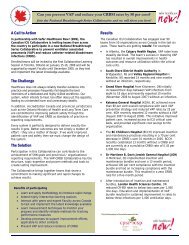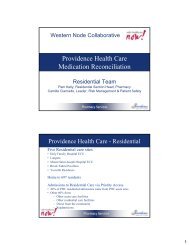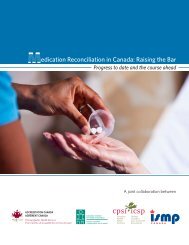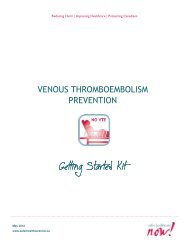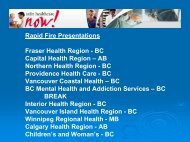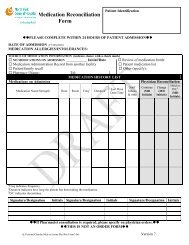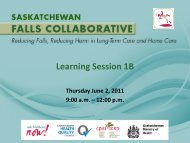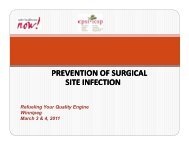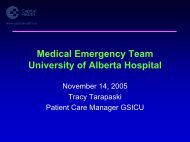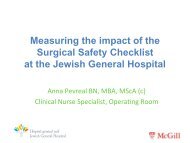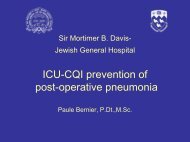VAP Getting Started Kit - Safer Healthcare Now!
VAP Getting Started Kit - Safer Healthcare Now!
VAP Getting Started Kit - Safer Healthcare Now!
You also want an ePaper? Increase the reach of your titles
YUMPU automatically turns print PDFs into web optimized ePapers that Google loves.
<strong>Safer</strong> <strong>Healthcare</strong> <strong>Now</strong>! Prevent Ventilator Associated Pneumonia <strong>Getting</strong> <strong>Started</strong> <strong>Kit</strong><br />
• Document oral care on a daily flow sheet.<br />
• Provide the appropriate equipment for oral care, tooth brushes for patients with<br />
dentition and swabs for those without dentition.<br />
4. Eliminate the routine use of instil for suctioning for pediatric patients<br />
The use of instil for suctioning is common practice in children based on the belief that it<br />
prevents the endotracheal tube from becoming blocked with secretions. There is no evidence to<br />
support this practice. 88, 89 There is evidence that instil flushes the biofilm coating the inside of<br />
50, 90<br />
the endotracheal tube into the lungs and might contribute to AP.<br />
What changes can we make that will result in improvement?<br />
• Educate the staff in regards to the risks vs. benefits of instil for suctioning.<br />
• Document any instances of blocked endotracheal tubes to evaluate the practice of<br />
not using instil.<br />
5. Keep the ventilator tubing in a dependant position<br />
Condensate from the humidified ventilator circuit can build up in the ventilator tubing. If the<br />
ventilator tubing is not in a dependant position the condensate can drain down the endotracheal<br />
tube washing the biofilm into the patient’s lungs. 86<br />
What changes can we make that will result in improvement?<br />
• Move the ventilators to allow the tubing to hang in a dependant position.<br />
• Take pictures of the tubing properly positioned and have them at the bedside for<br />
reference.<br />
Additional Components for the Pediatric Population<br />
• Hand Hygiene: As per the adult bundle<br />
• Use of oral decontamination solutions in children: Although there is no evidence in the<br />
literature for children the theory and risk assessment support this practice.<br />
Components of the Adult bundle which Are Not Included<br />
• Sedation Vacation: Sedation Vacations are not recommended for young pediatric patients due<br />
to the inability of the patient to comprehend what is happening. This might put them at risk<br />
for an unplanned extubation and reintubation which is a contributing factor for <strong>VAP</strong>. 13<br />
However, an appropriate assessment of the patients need for mechanical ventilation should<br />
be done on a daily basis as extubation is the most important factor in preventing <strong>VAP</strong>.<br />
• CASS-ETT: CASS-ETT are not currently available in common pediatric sizes.<br />
• Oral vs. Nasal endotracheal tubes. The science behind using oral vs. nasal endotracheal tubes<br />
was conducted in adults. 38, 39 In Children the axillofacial sinuses are not fully developed until<br />
12 years of age, 93 which conceivable reduces the possibility of the sinus being a source of<br />
bacteria and subsequent cause of <strong>VAP</strong>.<br />
• Given that there is no literature to support the use of oral vs. nasal tubes in children for the<br />
prevention of <strong>VAP</strong> and the risks of unplanned extubations associated with fixing of the<br />
endotracheal tube no recommendations are made with regards to oral vs. nasal tubes.<br />
June 2012 34



